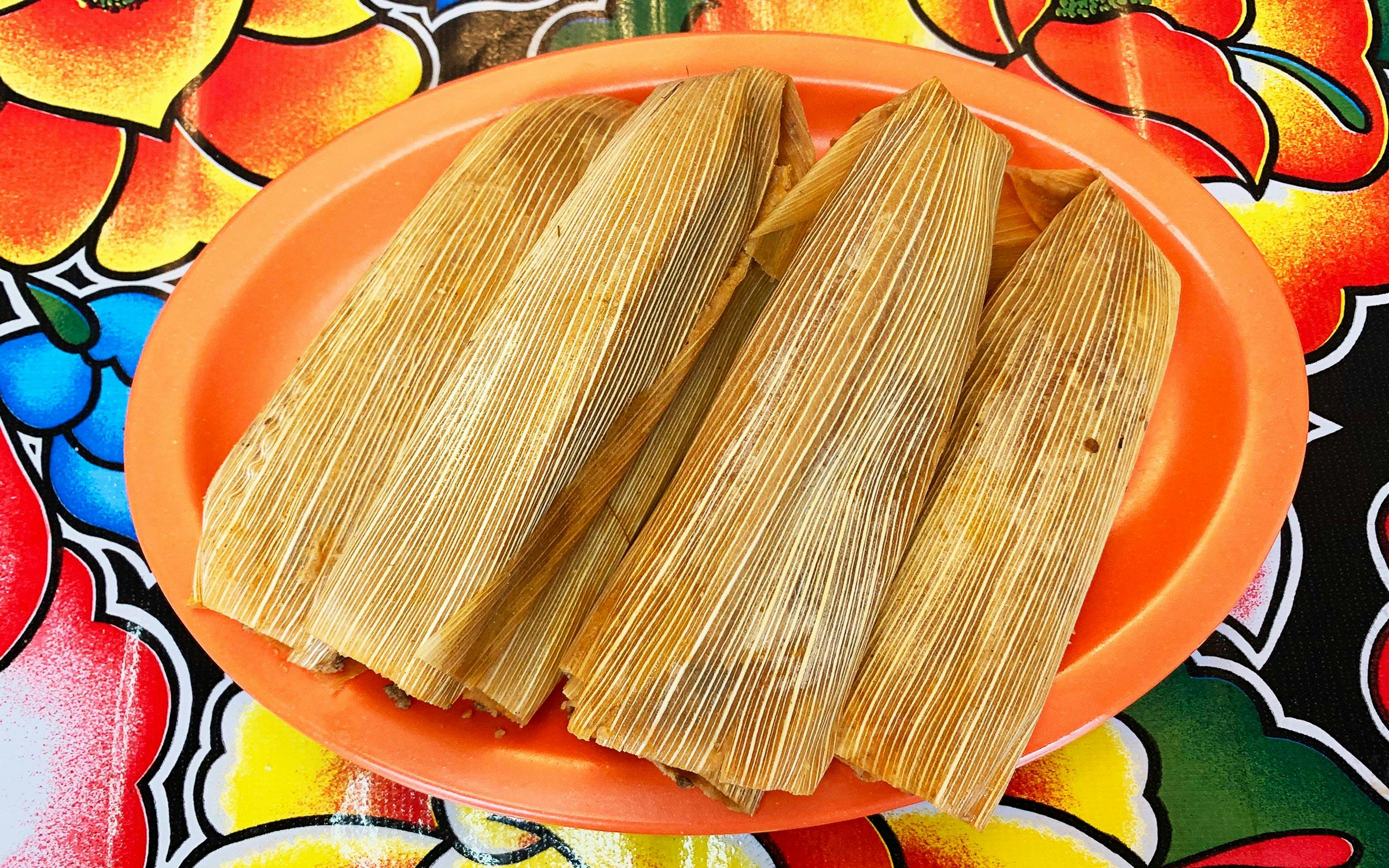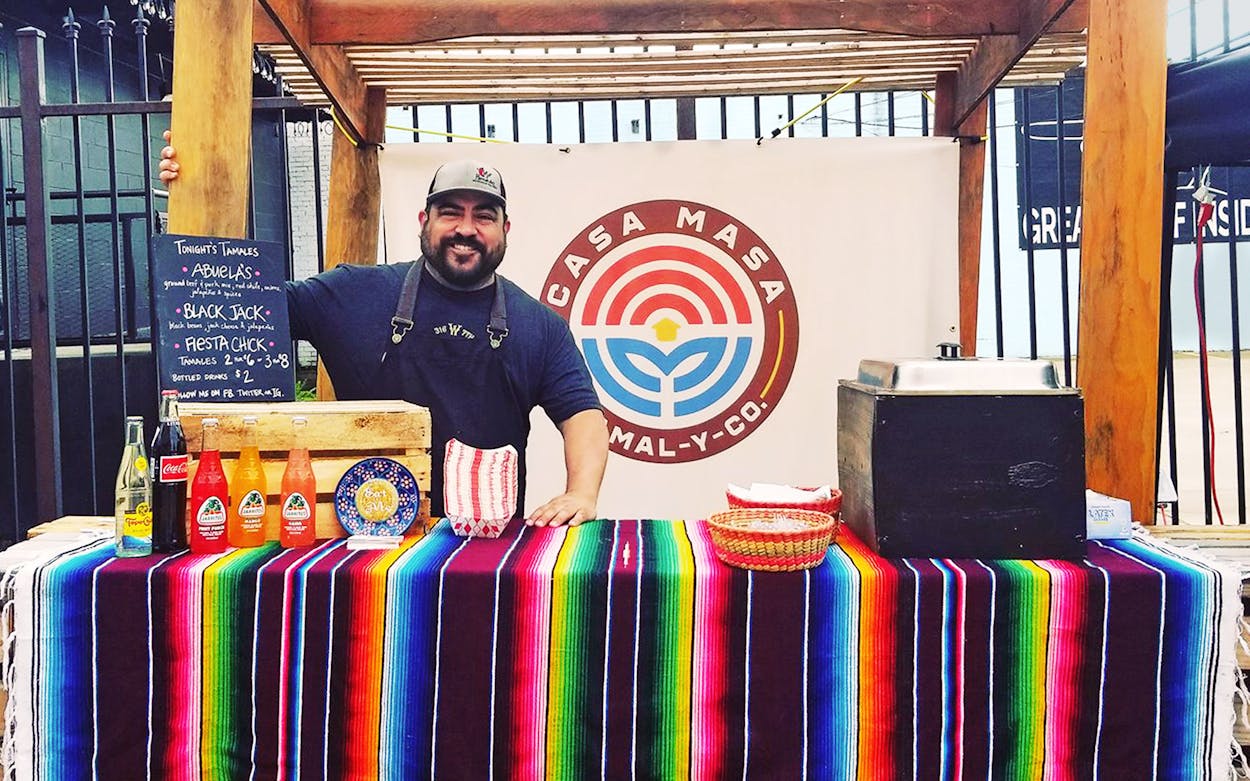The first time I met John Hernandez was in the parking lot of the Double Wide honky-tonk on the eastern outskirts of Dallas’s Deep Ellum neighborhood. It was fall 2017, and the watering hole was hosting a market of food vendors as a fundraiser for the victims of Hurricane Maria in Puerto Rico, as well as those suffering after the earthquake that had recently struck the Puebla region of Mexico. Hernandez was serving his tamales from the window of an Airstream trailer. A year earlier, he’d started his pop-up tamale company, Casa Masa, as a side gig and creative outlet while he juggled other restaurant industry jobs; if the eager line of customers was any indication, business was good. More than three years later, his success is “incredible,” he says.
I don’t think it’s difficult to believe: I fondly remember my first taste of the Casa Masa Abuela’s beef and pork tamal (the singular form of tamales in Spanish). It was slightly sweet, with a subtle, quick heat. The recipe, Hernandez explained, was his grandmother’s traditional picadillo blend with chiles and herbs. Another tamale was crammed with milky quesillo cheese and thin bands of roasted jalapeño and poblanos, while a third had an assortment of fall vegetables and greens. The spice level varied, but all were enjoyable. The affable gentleman was as eager to hock tamales as he was to chat. Yes, he makes every tamale by hand without help. And, yes, he learned from his mother and abuelita. In Mexican American communities, the majority of tamaleras (tamal-makers) are women; Hernandez is a rare tamalero.
He soaked up the skills by osmosis, he says. Hernandez grew up in El Campo, about an hour southwest of Houston, where his family owned a nursery and landscaping operation based in their home. As the youngest of five kids, Hernandez didn’t get much quiet time to himself. “Either I got into a fight with my brothers or they were picking on me,” he explains. He sought refuge by hanging out with his mother and grandmother while they made tamales. That was done a block away, at Hernandez’s grandmother’s house. It was nicer inside at his Abuela Emilia’s place, Hernandez says, especially on hot days. The older women were constantly cooking together. At first, he ate more than he cooked as he sat in the kitchen while they prepared tamales. But the more time he spent there, the more tasks he was given.
“It was really calming, mixing the masa and spreading it in the corn husk,” he says, adding with a laugh that its was cooler inside, too, especially in the summer. He was also introduced to the chisme (gossip) factor of tamal production. Perhaps as crucial as the food itself are the stories families share during tamaladas, or tamale-making parties. These are famously held at Christmas, but they can take place year-round as well. For Hernandez’s relatives, the gatherings were a key part of their social calendar. “What little Spanish I knew, I’d figure out whether they were talking about somebody,” he laughs.
When he was nine years old, in 1983, his family opened their own Tex-Mex restaurant, Casa Hernandez. He napped under the tables as a small child and later did his homework there. The restaurant remains in the family under the care of one of Hernandez’s brothers. The name for Hernandez’s tamales pop-up pays homage to his parent’s restaurant and to all the Tex-Mex joints of the eighties whose names were composed of the word “Casa” and the owners’ surname. When it came time to christen his own food operation, Hernandez says there was only one contender: “It couldn’t be anything but Casa Masa.”
Breweries and restaurants were among those who hosted Hernandez’s early pop-ups. They remain his supporters. He’s found steady success with a regular roster of tamales, including the Abuela’s, Queso and Rajas, and the Virtuous Veggie, as well as the standard red and green chicken and pork, all made by Hernandez’s hand. “I have to mix it with my hands. I can’t use a mixer. I have to feel when it’s ready,” he told me over a Zoom call punctuated by his frequent laughter. Spoken like a true tamalero.

That doesn’t mean there haven’t been skeptics. A man selling tamales is still shocking to some, and Hernandez reports being the subject of myriad double takes. The first was at his inaugural pop-up at a Lions Club farmers market outside a church on Oak Cliff’s tree-lined Tenth Street. An elderly woman walked up to his table with her arms crossed and a sour, distrustful look. In Spanish, she peppered Hernandez with questions about the tamales. His initial responses were in English. “I think that upset her more,” Hernandez chuckles. The viejita (old woman) would not be satisfied.
Eventually, Hernandez answered in passable Spanish. She asked who made the tamales. The tamalero answered that he had. The woman was confused. “But why does it say your abuela?” she asked. “I said, ‘Well, it’s her recipe, but I made it.’” He doesn’t normally hand out samples, but that day he made an exception. “Look, here, just eat this,” he instructed her with his hand outstretched. A slight smile formed on her wrinkled face. “Ay mijo, these are really good,” Hernandez recalls her saying with approval. He’s had similar experiences on other days with other viejitas, and a bite of his cooking usually converts them.
The process of making tamales is a dying art. The culinary matriarchs are dying, and most Texans aren’t up for the laborious, time-intensive preparation a great tamale requires. There are only so many people to fulfill orders, and once you find a coveted tamales hookup, you guard it carefully. Someone must continue the tradition. In Dallas, one of those people is John Hernandez.
Hernandez takes preorders via Instagram and Facebook for Saturday drive-through pickups at Encina (formerly Bolsa), near the Bishop Arts District. He sells tamales to Thunderbird Station, a new bar in Deep Ellum, for its Tamale Tuesday specials. Every other Saturday, he sets up at Peticolas Brewing Company in the Dallas Design District to feed participants in the brewery’s fun runs, but he lingers after the last person crosses the finish line because people have taken to preordering for his appearances there. He’ll be there this Saturday ahead of the Super Bowl.
Hernandez often sets up at local festivals, too, including at Latina-owned CocoAndré Chocolatier & Horchateria. At one CocoAndré event, my family and I ate our way through all of Hernandez’s varieties of tamales. My favorite Casa Masa tamal? Naturally, the Abuela’s. After that, it gets difficult to choose. The beautiful TX Star—a red-tinged pocket of smoky, ancho chile–rubbed fatty brisket—is a close second. The striking Pork Phat is an off-white masa casing filled with green chile pork; the sides of the ridges of the corn husk have a grassy hue. The Black Jack flavor mixes soft black beans with creamy quesillo. Tamales are already great. These are among the best.
Follow Casa Masa on Facebook and on Instagram for announcements of future pop-ups.








